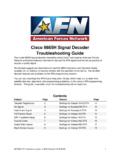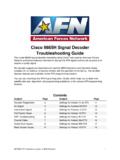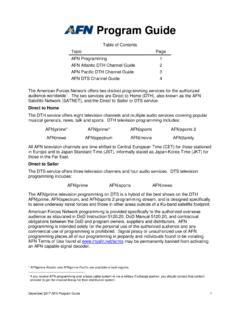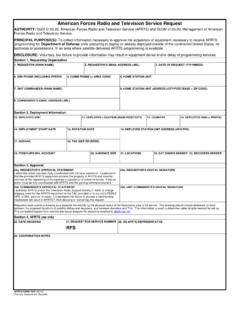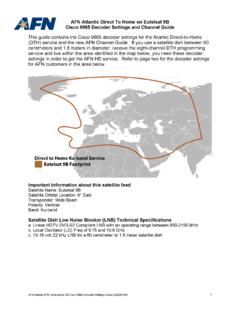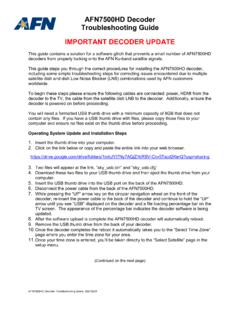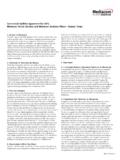Transcription of American Forces Radio & Television Service Request
1 May 2008. Requesting American Forces Radio and Television Service (AFRTS). The American Forces Radio and Television Service (AFRTS) operates the American Forces Network (AFN), a worldwide military Radio and Television broadcast network. AFRTS equipment can be obtained two ways, by direct purchase or temporary loan. Both options require submission of a completed Request for Service form to AFRTS. The form is at the end of this document. Programming on AFRTS is provided to the government at little or no cost by the program producers based upon the fact that we limit access to our programming to authorized audience members. This agreement is put into jeopardy by fraudulent use or distribution of AFRTS programming, which that could result in the termination of programming agreements.
2 This could essentially take AFRTS off the air. Do your part and safeguard this vital morale enhancer. Report lost or stolen decoders and suspected fraudulent use or distribution of the AFRTS signal directly to AFRTS at Access to AFRTS programming is restricted by DoD regulations. You are eligible to receive AFRTS programming if you meet the following criteria. Active Duty US military stationed or deployed overseas and their accompanying family members. DoD civilians assigned or deployed overseas and their accompanying family members. Direct Hire US Government State Department employees assigned overseas. DoD Direct Hire Contractors who are US citizens and directly sponsored by the host command. Retired US military members with a current DoD ID card.
3 DoD Contractors must meet additional eligibility requirements Command supported DoD contractors overseas must have an official identification card issued by the DoD, Combatant Command or Major Command. This ID must be presented at any military exchange in order to purchase a decoder. If purchasing a decoder through the mail, the supported command must fax or scan and email a copy of the ID to DSN 312-328-0624 (fax) or . Military commands may purchase decoders for use by authorized contractors, but the decoders must be registered to the command, not individual contractors. 1. Obtaining Loaned AFRTS equipment Loaned AFRTS equipment must be set up in an area where the majority of the troops assigned will have access to the programming. Systems set up in morale tents, mess tents or similar areas meet this requirement.
4 AFRTS satellite signal decoders, satellite dishes, low noise block converter (LNB's), line amplifiers and other equipment, excluding cable, that is released to a unit on a temporary loan must be returned to AFRTS upon completion of the deployment. The unit that receives AFRTS equipment is fiscally responsible for the gear until it is returned to AFRTS. AFRTS signal decoders are individually addressable and controllable, just like the commercial satellite providers Direct TV. por Dish Network in the United States. This means that AFRTS can turn off decoders that are missing, stolen or still activated after the date the receiving unit listed as their rotation date from the deployed location. It is critical each unit maintain frequent contact with the Air Force Broadcasting Service and update changes in location, rotation date or personnel responsible for AFRTS equipment in order to prevent decoder deactivation.
5 Worldwide RFS May 2008 Previous Editions Obsolete Page 1 of 8. May 2008. 2. Direct purchase of AFRTS equipment Units that deploy often are highly encouraged to use unit funds to purchase the equipment needed to obtain the AFRTS. signal. Purchasing the equipment will allow your unit near instant access to AFRTS programming at any deployed location practically anywhere on the planet outside the United States. Since you control the equipment, you won't have to wait for it to be shipped to you or run the risk of it getting lost in the supply system. All requests for purchase must be routed through the Air Force Broadcasting Service and AFRTS in order to obtain purchase authorization. Units can procure the Scientific Atlanta Model D9835 AFRTS integrated receiver/decoder (IRD) through the Television - Audio Support Activity site A help file is available on the "requisition on-line processing" page.
6 Here is the detailed FSC: 5820 NIIN: 01P800076 Description: Noun: RECEIVER, SATELLITE RECEIVER, SATELLITE; 4:2:0 NTSC CH3/4. Estimated Unit Cost: $ MODULATOR; ONE STEREO PAIR/TWO MONO. Unit of Issue: EA CHANNELS; CAPABLE OF RECEIVING DIGITALLY. Source of Supply: BS7 ENCRYPTED VIDEO, AUDIO AND VBI DATA;. Cage Code: 42061 PROVIDES VARIABLE RATE TO TRANSITION. Manufacturer: SCIENTIFIC ATLANTA EXISTING ANALOG Service TO DIGITAL; FREQ. Part Number: 4016130 RANGE: 950-2150 MHZ; 75 OHM IMPEDANCE;. Model Number: D9835 INCLUDES: FIELD UPGRADEABLE SOFTWARE. AND SECURITY, ON-SCREEN MENU FOR SETUP. AND STATUS, 64 USER-EDITABLE PRESET. CONFIGURATIONS, REMOTE CONTROL AND. POWER CORD (CUSTOMER MUST SPECIFY. COUNTRY OF ); ROHS-6. COMPLIANT; PWR RQMTS: 100-240 VAC, 50 ).
7 Several distributors offer dishes that will work with our satellite network. One example of an AFRTS-compatible off-the- shelf meter dish, LNBF and cable bundle comes from Patriot Antenna Systems. Many other sources are available, and can be found via Internet search. The following is an example of the accessories needed for the set up of the Patriot bundle: PTX-150 AZJ-GOV. 1) Ku-band meter offset antenna with AZ/EL mount (Ku band for use with the AFRTS Hotbird 4 satellite Service ). 1) Dual tray non-penetrating mount assembly 1) Wide band LNBF. 1) 100 foot length of RG-6 with F-connectors attached Cost of system is $ , plus shipping, for orders of 10-25 systems. Less then this amount, add another 25% to the amount for shipping and handling charges.
8 More information is available from Norm Bruner, Patriot Antenna Systems, (402) 545-2222, e-mail or 3. Levels of Service Levels of Service are tailored in scope from small to large. TVRO and L-Band distribution are the most common options in use today. A. Television Receive-Only (TVRO): This system consists of a single satellite dish and one decoder, feeding one to three televisions. This system is used in common-use areas (dayrooms, dining facilities, or other large-gathering areas) where one channel per group is sufficient. The channel viewed is determined by the channel selection on the signal decoder, and not the TV. If more than one TV is set up to one decoder, the same program channel will be seen on all TV's connected to the decoder. B.
9 L-Band Distribution: This system consists of one satellite dish feeding multiple decoders (normally 10 or less). Each decoder feeds one Television . L-Band systems are generally installed in small or mid-size buildings or compounds, and allow individual decoder users to select a specific AFN programming channel to view. Worldwide RFS May 2008 Previous Editions Obsolete Page 2 of 8. May 2008. C. Cable Television Head-End (CATV): CATV systems consist of a pre-wired rack of equipment designed to supply individual AFRTS video-level signals to multiple points, usually at fixed, larger locations. These multiple points, or drops, allow a customer to connect a Television to the cable system and receive AFRTS programming without the need for a dedicated decoder.
10 CATV is usually installed at bases or in large buildings, and may feed as many as 300 drops. Due to the complexity of this system, a site survey must be conducted by AFRTS personnel at the requesting unit's expense. A. CATV system head-end system also must be purchased by the requesting unit. D. Microwave Multi-Point Distribution System (MMDS): This is basically wireless cable. The programming signal is acquired from the satellite and broadcast over the MMDS system. To receive programming, each building or tent would need a down converter. The converter receives the signal that is then fed into the structure via co-axial cable. The MMDS system is ideal for temporary or highly flexible base camps, in that cable trenching is not required and adding or eliminating Service to areas is as simple as installing or removing the down converter.
